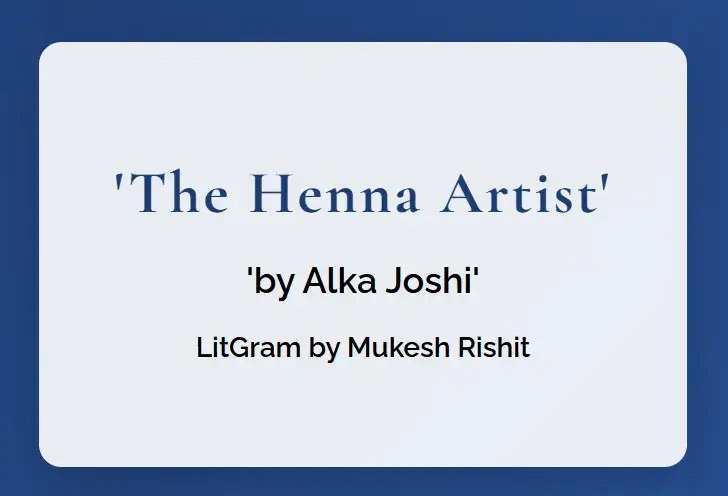Introduction: The Henna Artist
Has the grace of henna patterns ever caught your eye? Have you spotted beauty in how tradition and modern life blend? The Henna Artist by Alka Joshi pulls us into a world where henna art stands for change. With rich details and moving words, this book brings each page to life. It pushes you to look past the story into a space of cultural signs and personal growth.
Overview: What’s The Henna Artist About?
The Henna Artist takes place in India during the 1950s, specifically in the vibrant city of Jaipur, known as the “Pink City.” The book tells the story of Lakshmi Shastri, a skilled henna artist who deals with social limits, personal struggles, and the search for freedom. The novel is full of historical background and cultural specifics, but its core focuses on Lakshmi’s journey to find herself. It asks: How can someone gain control of their life in a world full of obstacles using only art and inner power?
About the Author: Alka Joshi
Alka Joshi, born in Rajasthan, India, and raised in the USA, tells stories that paint a true picture of Indian culture. Her unique way of writing, backed by her deep knowledge of history and culture, brings her characters to life. Alka Joshi weaves her own experiences and love for traditional art into her tales, making her work connect with readers in many ways. Each page reminds us that the past isn’t just history—it still shapes our present.
Setting and Historical Context: 1950s India
Set in the lively 1950s India, particularly in Jaipur, Rajasthan, the book shows a society in flux. The time after colonial rule saw old customs clashing with new ideas. Alka Joshi brings to life busy streets, bright markets, and hidden spots in a changing world. This setting isn’t just a backdrop; it’s a key player that shapes the hopes, fears, and battles of the people living in it.
The Art of Henna: Cultural and Symbolic Significance
Henna plays a crucial role in this novel beyond just decorative art—it serves as a ceremony, a form of communication, and an emblem of change. People apply it during festive events, marriages, and significant life milestones, and henna represents beauty, good fortune, and life’s fleeting nature. As you delve into the story, each detailed pattern turns into a symbol charting the characters’ inner evolution. How can a basic skin design reflect life’s intricacies? This question is one of the many puzzles Alka Joshi reveals.
Plot Without Spoilers: A Path to Self-Understanding
Here’s a sneak peek without spoiling too much: The story revolves around Lakshmi, our tough main character, who works her way through life’s maze in Jaipur. From broken hearts to society’s rules, her path is like putting on henna—each design shows more of her complex tale. As she shifts from a life controlled by outside forces to one where she stands up for herself, readers get to see a change that’s both inspiring and very personal. The arrival of her long-lost husband, Hari, and a sister she never knew, Radha, further complicates her journey.
Narrative Style and Storytelling Techniques
Joshi writes in a way that’s both poetic and easy to understand. Her story doesn’t follow a straight line. Instead, it jumps back and forth using memories and thoughts to show how our minds work—complex, layered, and surprisingly beautiful. Think about how old photos can make you feel a rush of emotions. That’s how the story unfolds. She pays close attention to tiny details and uses vivid descriptions. This makes you feel like you’re right there in every scene of Jaipur’s bustling streets and opulent palaces.
Themes: Empowerment, Tradition vs. Modernity, and Identity
Empowerment Through Self-Reliance
Female empowerment stands out as a key theme in the novel. Lakshmi’s grit and resolve to shape her own future challenge the social rules of her era. Joshi prompts readers to ponder: How can we find power in our weak spots? The key lies in loving what you do, taking chances, and always trying to better yourself.
The Push and Pull of Old and New
With history as its backdrop, the book weighs old ways against new ideas in post-independence India. While familiar customs give us a sense of who we are, they can also hold us back. Joshi catches this two-sided nature well, making us think about how we deal with change and staying the same in our own lives.
Art as a Symbol of Who We Are
Art, henna in this book, serves as a way to express oneself. Lakshmi’s story unfolds like a detailed painting, with each intricate pattern representing different parts of who she is. By combining art with storytelling, the book takes a deep look at what it means to be yourself.
Character Analysis: Examining the Main Character and Important People
The Strong-Willed Henna Artist
Lakshmi Shastri is the essence of this tale—a person who breaks from tradition to gain personal freedom. She’s a mix of opposites: fragile but tough, quiet but self-reliant. As she changes throughout the story, we see not just her own growth but also the big changes happening in society around her.
The Supporting Cast
Every great lead character has other people who shape their story. From family members like Hari and Radha who stand for old-fashioned limits to surprise friends like Malik (her young assistant) and Dr. Jay Kumar who bring hope and bravery, each side character adds to the story. Their unique backgrounds and problems make Lakshmi’s journey more complex and real.
How Art Changes People
Art in The Henna Artist has more than a decorative role—it has a transformative effect. Think about the careful application of henna: every curve and dot has a purpose, and as the pattern grows, it reflects a person’s development. In the same way, the process of making art becomes a symbol for remaking oneself and starting fresh. Joshi shows that art can drive change, encouraging us to find beauty in each step of transformation.
Cultural Impact: Reader Reception and Global Resonance
Since it came out, The Henna Artist has resonated with many different readers. Critics have praised its vivid writing and deep cultural understanding, while readers have found solace and motivation in Lakshmi’s story. The book goes beyond geographic and cultural limits, appealing to people everywhere. This worldwide connection shows us that stories based on tradition can still relate to modern life.
Lessons to Be Learned from The Henna Artist
What can we learn from this rich story? One clear lesson is how important it is to keep going when things get tough. Lakshmi’s journey shows us that accepting change, even when it’s scary, can help us feel better about ourselves and more in control. Also, the book reminds us to value and keep our cultural roots even as we make new paths in a world that’s always changing.
Final Thoughts: More Than Just a Story
In the end, The Henna Artist by Alka Joshi mixes history, personal growth, and art in a captivating way. It questions usual stories and shows us the special parts of everyday life in 1950s Jaipur. As you read, you might realize you’re not just learning about a henna artist—you’re also discovering parts of yourself and your own strength. With every careful design, Joshi shows us that our lives are as detailed and beautiful as the art that marks them.
Rapid Recap
💡 ART & CULTURE
The Power of Henna in 1950s India
• Henna as a symbol of beauty and transformation
• Traditional art reflecting cultural heritage
• Visual storytelling through intricate designs
Literature Connect: Art, Culture & Heritage
💪 SOCIETY & EMPOWERMENT
Redefining Women’s Narratives
• A protagonist’s journey of self-reliance and courage
• Challenging traditional gender roles
• Empowerment through artistic expression
Literature Connect: Society & Women Studies
⏳ TRADITION VS. MODERNITY
The Dance of Old Customs and New Aspirations
• 1950s India as a melting pot of change
• The interplay between tradition and modernity
• How cultural transitions shape personal identity
Literature Connect: Modern Indian History & Society
✍️ NARRATIVE TECHNIQUES
The Art of Storytelling in The Henna Artist
• Non-linear narrative mirroring the layering of henna
• Flashbacks that evoke deep emotions and historical context
• Symbolic design elements that serve as metaphors for transformation
Literature Connect: Literary Criticism & Analysis
🏛️ SETTING & HISTORY
1950s India: A Backdrop for Change
• Post-colonial influences on art and society
• A cultural setting that becomes a character in itself
• History enhancing character development and narrative depth
Literature Connect: History & Cultural Evolution
📚 READING TIPS & DISCUSSION POINTS
How to Dive Deep into The Henna Artist
• Reflect on the symbolism behind each henna design
• Discuss female empowerment in a historical context
• Explore the tension between tradition and change
• Compare the narrative techniques with other literary works
Literature Connect: Discussion-Based Analysis
🎯 FOCUS POINTS
Remember These Key Aspects:
• The cultural significance of henna in rituals
• The impact of non-linear storytelling on emotional depth
• How women overcome societal constraints
• The fusion of traditional customs with modern aspirations
✍️ PRACTICE QUESTION
“Discuss how traditional art forms, such as henna, serve as a catalyst for female empowerment and cultural identity in 1950s India, drawing examples from The Henna Artist by Alka Joshi.” (250 words)
💭 THOUGHT FOR THE DAY
“In every mark of henna lies a story of resilience and hope.”
📝 QUICK REVISION POINTS
• Henna’s cultural significance and symbolism
• Non-linear narrative mirroring personal growth
• Female empowerment in the context of traditional norms
• The dynamic setting of 1950s India driving transformation
🔍 CONNECTING THE DOTS
Cultural Heritage & Identity
• Using traditional henna art as a narrative device
• Showcasing female empowerment within historical literature
• The fusion of past traditions and modern challenges in societal reform
📊 CULTURAL INDICATORS
• The transformative cultural shifts in 1950s India
• Visual motifs such as detailed henna designs acting as narrative symbols
• The evolution of women’s roles as depicted in historical contexts
🌐 GLOBAL IMPACT
• The universal appeal of empowerment through artistic expression
• Ongoing relevance of tradition in today’s cultural debates
• How historical narratives cross cultural boundaries and inspire conversations


